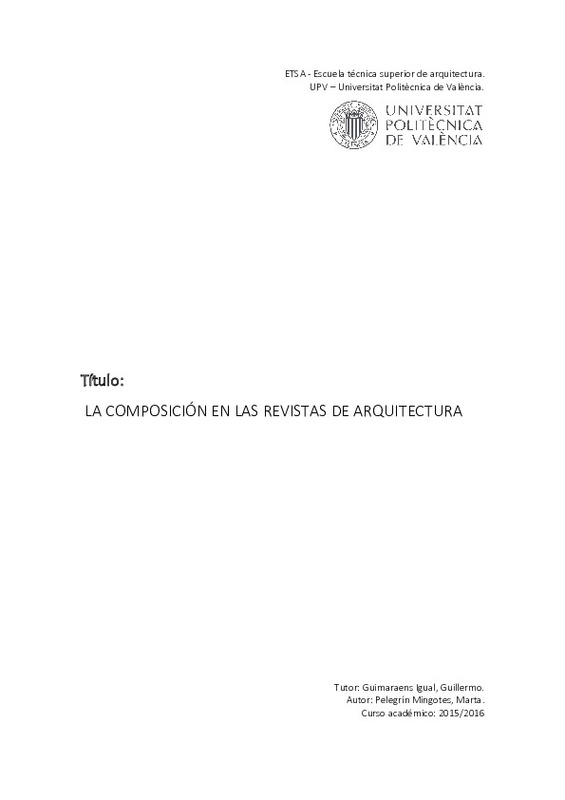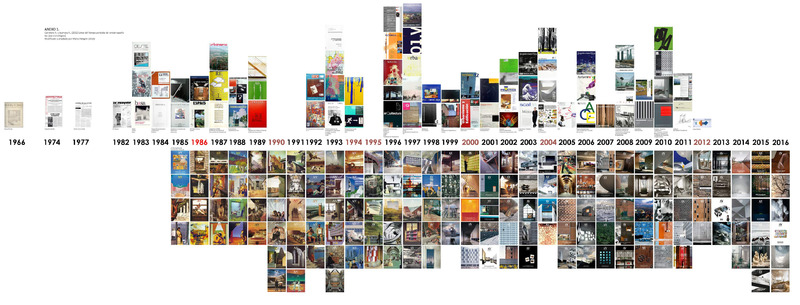|
Resumen:
|
La necesidad que actualmente tiene el diseño de revistas de arquitectura en formato papel de
afianzar su personalidad reclama un creciente grado de sofisticación. Por ello, la continua
adquisición de nuevos conocimientos ...[+]
La necesidad que actualmente tiene el diseño de revistas de arquitectura en formato papel de
afianzar su personalidad reclama un creciente grado de sofisticación. Por ello, la continua
adquisición de nuevos conocimientos y habilidades es algo fundamental para un diseñador
gráfico en una profesión donde la competencia es cada vez más severa.
La composición de las revistas requiere de diseñadores y editores capaces de dirigir y concentrar
sus esfuerzos en la creación de jerarquías. Ellos, han de ser capaces de responder a las nuevas
necesidades de los lectores, realizando cambios que permitan continuar con el legado de las
revistas arquitectónicas. El impacto visual que genera el orden de una página de revista, puede
ser un factor determinante para la captación de nuevos lectores, por lo que es esencial prestar
especial atención al proceso de diseño. El uso del color, la selección y los cuerpos de la tipografía,
el brillo del papel, y la claridad de la maqueta están dictaminados por las necesidades de los
usuarios.
La fidelidad, perseverancia y dedicación de los diseñadores editoriales, ha conseguido sobrevivir
dos crisis: la económica y la sectorial, que han perjudicado profundamente al gremio de la
arquitectura. Hoy en día, una tercera crisis se avecina, la del papel, siendo progresivamente
sustituido por una continua digitalización del mismo. ¿Serán capaces de resistir a una tercera? Y
si es así, ¿cuáles son los parámetros a tener en cuenta para conseguir mantenerse con energía y
vigor en el mercado?
Los diseñadores deberán de conseguir que una publicación se desmarque sin dejar de ser
contemporánea y tener estilo, teniendo claro cuáles son los aspectos compositivos que más
trascendencia tienen en sus lectores, para así poder realizar las permutas necesarias con el fin de
seguir contribuyendo al desarrollo cultural, educativo y formativo.
[-]
Nowadays, the requirement for designing architectural magazines on paper to strengthen its
personality, demands an increasing degree of sophistication. Therefore, the continuous
acquisition of new knowledge and skills ...[+]
Nowadays, the requirement for designing architectural magazines on paper to strengthen its
personality, demands an increasing degree of sophistication. Therefore, the continuous
acquisition of new knowledge and skills is critical for a graphic designer in a profession where
competition is increasingly severe.
The composition of magazines requires designers and editors to be able to direct and focus their
efforts on creating hierarchies. They must be effective to respond to the new requisites of
readers, making changes that allow to continue the legacy of architectural magazines. The visual
impact generated by the layout of a magazine page, can be a determining factor to attract new
readers, so it is essential to pay special attention to the design process. The use of color, selection
and bodies of typography, paper brightness and clarity of the model are dictated by the needs of
users.
Faithfulness, perseverance and the dedication of the editorial designers managed to survive the
economic and sectoral crisis, which have deeply hurt the architectural conception. Today, a third
crisis is about to come: the paper is being progressively replaced by a continuous digitization of
it. Will they be able to resist a third crisis? And if so, what are the parameters to consider for
staying with energy and vigour in the market?
Designers should get a publication unchecked (si te refieres a que destaque utiliza mejor
distinguished o higlighted) without losing the essence of being contemporary and having style at
the same time, taking clear what are the most transcendent compositional aspects on their
readers, so they can make the necessary exchanges in order to continue contributing to cultural
development , education and training.
[-]
|








